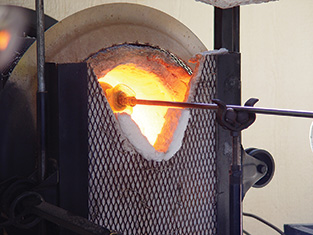
A Century of Refractories
ASTM International Committee C08 Contemplates Past, Present and Future
The term "refractory" is defined in C71, Terminology Relating to Refractories, as "nonmetallic materials having those chemical and physical properties that make them applicable for structures, or as components of systems, that are exposed to environments about 1000?F (538?C)."
In other words, if you can't stand the heat, you're not a refractory.
C71, along with more than 70 other standards, was developed by ASTM International Committee C08 on Refractories, which is celebrating its 100th anniversary this year. ASTM Committee C08 was founded in 1914 to develop standards for refractory materials, which are used to build a various structures that are routinely subjected to high temperatures.
"I believe that C08 has made significant contributions to the refractories industry through its long history," says Samuel Bonsall, research associate, advanced refractories division, Vesuvius, Bettsville, Ohio, and current chairman of C08. "The standards developed in this committee have defined what a refractory is, classified them by type and function and defined key test methods to determine their suitability for a given application."
In the early decades of C08's existence, refractories would have been used to build the linings of fireplaces, stills and kilns, among other applications. The astonishing technological advances of the 20th century expanded the use of refractories to include the linings of nuclear reactors and the reentry heat shields for space shuttles.
"At C08's beginning, which could also be equated to the beginning of the modern era of refractories, there were no standard methods available to evaluate supposedly equivalent materials," says Leonard Krietz, vice president, research and development, Plibrico Co. LLC, Chicago, Ill., currently chairman of C08's awards subcommittee. "With the coming of standardized tests, manufacturers and consumers had the tools to benchmark a refractory's performance to a test result. This enabled the means to evaluate and develop new materials in the lab for improved performance in actual application."
Some of the key standards developed by C08 include:
- C20, Test Methods for Apparent Porosity, Water Absorption, Apparent Specific Gravity, and Bulk Density of Burned Refractory Brick and Shapes by Boiling Water;
- C357, Test Method for Bulk Density of Granular Refractory Materials; and
- C862, Practice for Preparing Refractory Concrete Specimens by Casting.
Bonsall notes that C704/C704M, Test Method for Abrasion Resistance of Refractory Materials at Room Temperature, has also emerged as an important C08 standard.
"C704 has had a huge impact on the petroleum processing industry in defining suitable refractories," says Bonsall. "Efforts in the committee have been directed to reducing the variability of the test method as well as developing a new, more severe test for extremely abrasion resistant materials, in recognition of the ongoing improvements in refractories."
On the future of the committee, Bonsall says, "C08 has managed to survive the last 30 or so of globalization of the world economy and the consolidation and restructuring of major users of refractories such as the steel industry. My hope is that we can generate new interest and appreciation for the work of Committee C08."
Committee C08 will celebrate their 100th anniversary on March 26, during the March 25-26 C08 meetings to be held in St. Louis, Mo., in conjunction with the St. Louis section of the American Ceramic Society. For more information on the March meetings and celebration, contact Kathleen McClung, manager, ASTM (phone: 610-832-9717).
 SN Home
SN Home Archive
Archive Advertisers
Advertisers Masthead
Masthead RateCard
RateCard Subscribe
Subscribe Email Editor
Email Editor